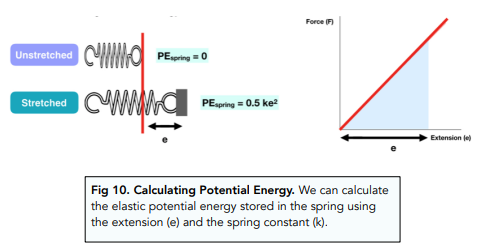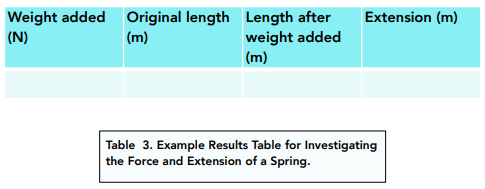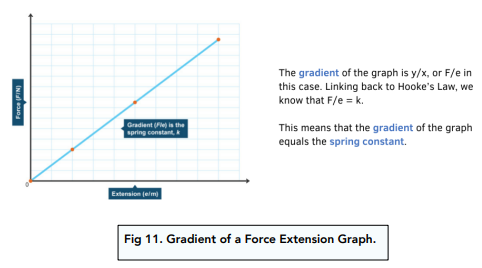Work Done in a Spring (GCSE Physics)
Work Done in a Spring
Work Done in a Spring
Energy Transfers
- Forces do work on springs. When a force acts on a spring to compress or stretch it, the force is doing work. We previously mentioned that doing work is simply another way to talk about the transfer of energy.
- Energy is transferred into elastic potential energy in the spring. As the force acts on a spring, all of its energy will be transferred into elastic potential energy (EPE). This elastic potential energy will become stored in the spring and transferred into another form of energy later on.
- Usually the work done is equal to the EPE stored. When an object is elastically deformed, all of its energy will be transferred into EPE. Therefore the work done will be equal to the EPE stored. However, if the object is in-elastically deformed (i.e. we have passed the limit of proportionality), this isn’t the case.
Calculating Work Done in a Spring
When a spring changes shape, for example when stretched or compressed, we can calculate the amount of work done and energy transferred to EPE.
Remember, we can only calculate the work done up to the limit of proportionality (the point at which force and extension are no longer in a proportional relationship).
This is the equation for calculating the work done when compressing or stretching a spring:

Where:
- Ee is elastic potential energy, measured in joules, J
- k is the spring constant, measured in Newtons per metre, N/m
- e is the extension, measured in metres, m.

The area under the force-extension graph is equal to the potential energy stored. This is the graph with the straight line not the curved line, because if we go beyond the limit of proportionality we cannot calculate elastic energy (or we can, but you don’t need to know about it!).
Question: A spring is stretched by 50cm. The spring constant for the spring is 30 N/m. What is the elastic energy (in J) stored in the spring?
1. Convert the extension into the correct units.
The spring constant is in newton-metres, so our extension needs to be in metres.
50cm = 0.5m.
2. Calculate the elastic energy
Ee = 0.5 ke²
E = 0.5 x 30 x 0.5 = 7.5J
Question: What is the relationship between work done and elastic` potential energy in a spring which is being stretched? (2 marks)
Mark 1 – Work done is proportional to elastic potential energy stored in the spring.
Mark 2 – Until the limit of proportionality.
Investigating Force and Extension of a Spring
Method
- Set up a clamp stand with a spring. Attach a spring to the end of a clamp stand. Make sure that there are no weights hanging off the end of the spring.
- Measure the unextended spring. Place a ruler just behind the spring, so that you can read off a value for the length of this unextended spring. Make a note of this value, ensuring that the unit you record is metres.
- Add a weight to the spring. Next, attach a weight to the other end of the spring. The spring will extend.
- Measure the extension. Wait until the spring has stopped moving and carefully read off a new value for spring length. Make sure that you are reading off your values at eye level to prevent any errors from occurring.
- Record your results. Record your results in a table with the following headings:


Work Done in a Spring is a concept in physics that refers to the energy transferred to or from a spring when it is compressed or stretched. It is calculated by multiplying the force applied to the spring by the distance it is moved.
Hooke’s Law is a principle in physics that states that the force required to extend or compress a spring is proportional to the distance it is moved. This means that the more you compress or stretch a spring, the more force it will take to keep it compressed or stretched.
Work Done in a Spring is calculated using the equation: Work Done = Force x Distance. The force is the force applied to the spring, and the distance is the distance that the spring is moved.
Elastic Potential Energy is the energy stored in a spring when it is compressed or stretched. When a spring is compressed or stretched, it stores energy that can be used to perform work when it is released.
The Work Done on a spring is equal to the change in Elastic Potential Energy of the spring. This means that when you do work on a spring, you are transferring energy into the spring, which is stored as Elastic Potential Energy.
Yes, Work Done in a spring can be negative. This occurs when the force applied to the spring is in the opposite direction to the displacement, causing the spring to release energy.
No, the same amount of Work Done cannot be done on a spring with different forces. The amount of Work Done depends on both the force applied to the spring and the distance it is moved.
The stiffness of a spring, also known as its spring constant, determines the amount of force required to compress or stretch the spring a certain distance. A spring with a high stiffness requires more force to compress or stretch than a spring with a low stiffness. This means that the amount of Work Done in a spring depends on its stiffness.





Still got a question? Leave a comment
Leave a comment